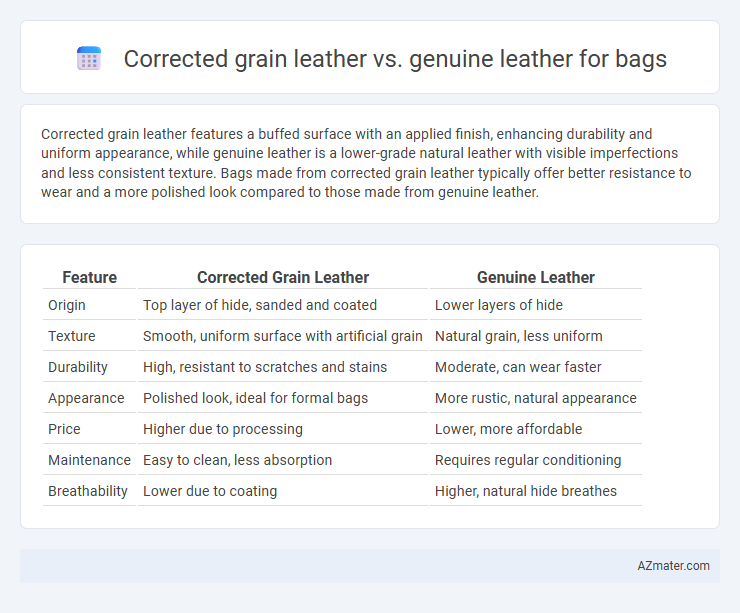Corrected grain leather features a buffed surface with an applied finish, enhancing durability and uniform appearance, while genuine leather is a lower-grade natural leather with visible imperfections and less consistent texture. Bags made from corrected grain leather typically offer better resistance to wear and a more polished look compared to those made from genuine leather.
Table of Comparison
| Feature | Corrected Grain Leather | Genuine Leather |
|---|---|---|
| Origin | Top layer of hide, sanded and coated | Lower layers of hide |
| Texture | Smooth, uniform surface with artificial grain | Natural grain, less uniform |
| Durability | High, resistant to scratches and stains | Moderate, can wear faster |
| Appearance | Polished look, ideal for formal bags | More rustic, natural appearance |
| Price | Higher due to processing | Lower, more affordable |
| Maintenance | Easy to clean, less absorption | Requires regular conditioning |
| Breathability | Lower due to coating | Higher, natural hide breathes |
Overview: Corrected Grain Leather vs Genuine Leather
Corrected grain leather undergoes surface sanding and embossing to mask imperfections, resulting in a more uniform and durable finish ideal for bags requiring consistent texture. Genuine leather, derived from the lower layers of animal hide, retains natural marks and offers flexibility but varies in quality and appearance. For bag manufacturing, corrected grain leather provides enhanced abrasion resistance, while genuine leather delivers authentic character and breathability.
Defining Corrected Grain Leather
Corrected grain leather is a type of leather that has been sanded and buffed to remove imperfections, then coated with a finishing layer to create a uniform appearance, commonly used in bags for its durability and consistent texture. Genuine leather refers to real animal hide but includes lower-quality layers beneath the top grain, often less refined than corrected grain leather. Corrected grain leather offers enhanced aesthetic appeal and surface protection, making it a popular choice for stylish and durable bags.
What is Genuine Leather?
Genuine leather is a type of leather made from the lower layers of animal hide, typically derived from split leather, and is often coated with a surface layer to improve appearance. It is less durable and less expensive compared to corrected grain leather, which is made from the top layer of the hide and undergoes heavy processing to remove imperfections. Genuine leather offers a more affordable option for bags but may lack the refined texture and longevity found in corrected grain leather products.
Manufacturing Process Differences
Corrected grain leather undergoes a sanding or buffing process to remove imperfections from the hide's surface, followed by the application of an artificial grain layer, often using pigments and embossing to enhance uniformity and durability. Genuine leather is crafted from real animal hides that are tanned and finished without significant alteration to the natural grain, preserving the original texture and character of the leather. The manufacturing process of corrected grain leather involves more surface treatment and coating steps, resulting in a more consistent appearance but less natural breathability compared to the minimally altered genuine leather.
Durability: Which Leather Lasts Longer?
Corrected grain leather undergoes sanding and coating to enhance surface uniformity, providing moderate durability suitable for bags exposed to everyday wear but less resistant to deep scratches over time. Genuine leather, being less processed and retaining more natural grain, offers higher durability and ages gracefully, often lasting longer with proper care and developing a unique patina. For long-term durability and resilience, genuine leather generally outperforms corrected grain leather in bag construction.
Appearance and Texture Comparison
Corrected grain leather features a buffed surface with an added pigment layer, resulting in a uniform and smooth appearance that masks natural imperfections, ideal for consistent texture in bags. Genuine leather retains its original grain, showcasing natural markings and a more textured, varied surface that enhances the leather's authenticity and character. The corrected grain leather feels more coated and less breathable, while genuine leather offers a softer, more supple touch with natural pore visibility.
Cost Comparison: Value for Money
Corrected grain leather bags offer a more affordable option compared to genuine leather, providing a balance between durability and price. Genuine leather tends to be more expensive due to its natural texture and higher quality, which often translates to longer-lasting products. Consumers looking for value for money may prefer corrected grain leather, as it offers a stylish appearance at a lower cost without significantly sacrificing durability.
Maintenance and Care Needs
Corrected grain leather requires regular conditioning to prevent drying and cracking due to its sanded and coated surface, while genuine leather demands more frequent cleaning and moisturizing to preserve its natural texture and flexibility. Bags made from corrected grain leather often show fewer stains and require less intensive cleaning since the protective topcoat resists water and dirt. Genuine leather benefits from breathable storage and protection against excessive moisture to maintain its durability and rich appearance over time.
Best Uses: Choosing for Different Bag Styles
Corrected grain leather, with its smooth finish and durability, is ideal for structured bags like totes and satchels that require a polished appearance and resistance to wear. Genuine leather, known for its natural texture and breathability, suits casual and soft bags such as slouchy hobo bags or crossbody styles where flexibility and a more organic look are preferred. Selecting the right leather depends on the desired bag style, balancing aesthetics, durability, and function.
Eco-Friendliness and Ethical Considerations
Corrected grain leather involves buffing and re-coating hides, often requiring more chemicals and synthetic finishes, which can increase environmental impact compared to genuine leather that retains the natural grain with minimal processing. Genuine leather typically has a longer lifespan, reducing waste and resource use over time, aligning better with eco-friendly practices. Ethical considerations favor genuine leather when sourced from responsible tanneries committed to sustainable practices and animal welfare, whereas corrected grain leather may come from lower-quality hides, raising questions about material sourcing and manufacturing ethics.

Infographic: Corrected grain leather vs Genuine leather for Bag
 azmater.com
azmater.com